If you find yourself with extra fresh ginger, there are several practical and beneficial ways to put it to good use. Ginger, known for its strong, spicy flavor, is a versatile ingredient that can elevate a variety of dishes and drinks. Beyond its culinary uses, ginger is also lauded for its health benefits, containing gingerol, which is believed to have anti-inflammatory and antioxidant properties.

Understanding how to store ginger properly can extend its shelf life, allowing you to enjoy its flavor and health advantages for a longer period. For short-term use, place ginger in a plastic bag in the refrigerator’s crisper drawer. If you plan to keep it for a few weeks or longer, freezing ginger is an effective method. Grate or slice it before freezing for convenience when cooking later on.
Integrating ginger into your meals goes beyond just mincing and adding it to stir-fries or soups. You can make a soothing ginger tea, blend it into smoothies, or prepare a ginger-infused honey that can be drizzled over desserts or mixed into dressings. These uses not only make your dishes more flavorful but also help you incorporate ginger into your diet to potentially reap its associated health benefits.
Storing Fresh Ginger for Longevity
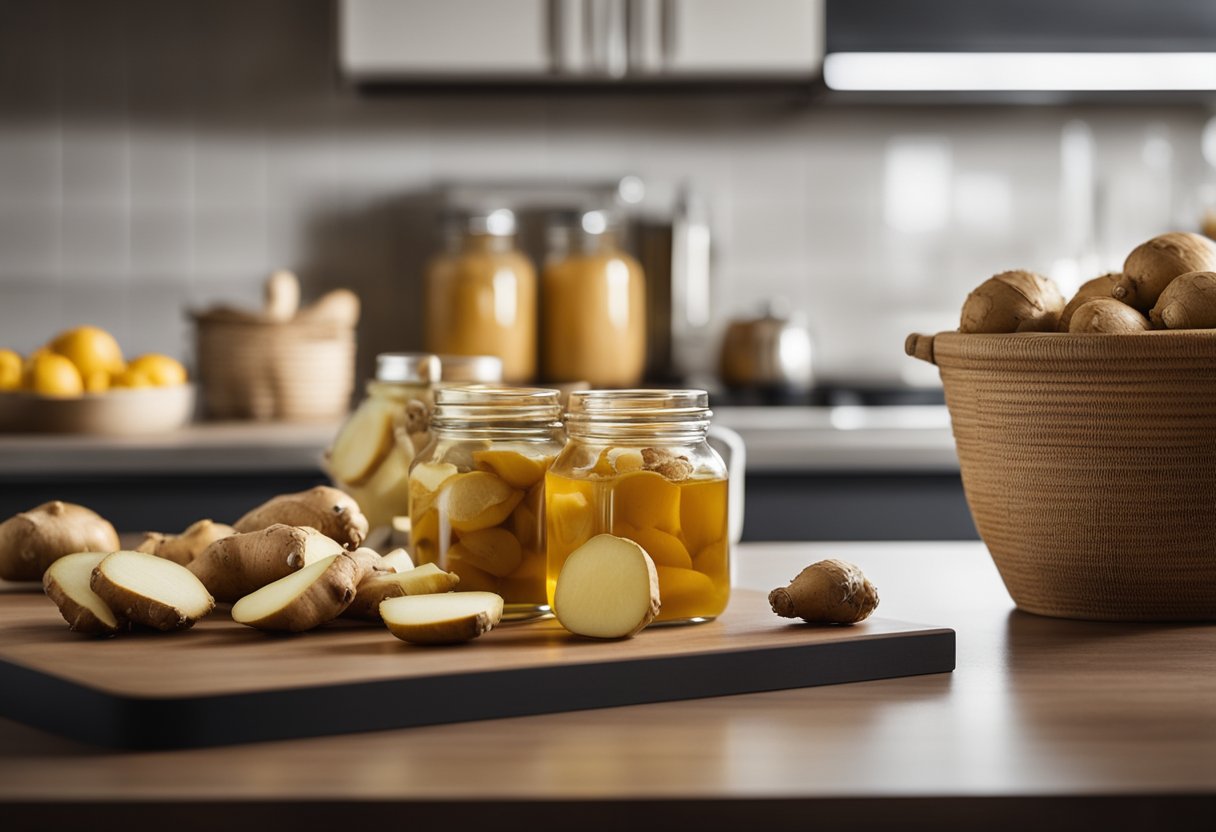
Proper storage of fresh ginger can significantly extend its shelf life. Learn how to refrigerate and freeze ginger effectively to maintain its freshness and flavor for as long as possible.
Refrigerating Ginger Correctly
To keep ginger fresh in the refrigerator, start by placing the fresh ginger root in a resealable plastic bag. Make sure to expel as much air as possible before sealing the bag. This method helps to prevent moisture and mold, which can cause the ginger to spoil.
- Steps for Refrigerating Ginger:
- Find a resealable plastic bag.
- Place the ginger root inside.
- Squeeze out excess air and seal tightly.
- Place in the crisper drawer of your refrigerator.
By following these steps, ginger can remain fresh for up to three weeks.
Freezing Techniques for Ginger
Freezing ginger can preserve it for several months. To effectively freeze ginger, you should first peel and grate it, or chop it, depending on your future culinary needs. Then, use a freezer bag or an airtight container to store it in the freezer.
- Guide to Freezing Ginger:
- Peel and Grate/Chop ginger.
- Arrange the ginger on a baking sheet to pre-freeze.
- Once solid, transfer to a freezer bag.
- Label with the date before placing it in the freezer.
When you need ginger for a recipe, you can take out the required amount and either let it thaw for a few minutes or directly add it to your dish. Frozen ginger can last up to six months for optimal flavor and quality.
Culinary Uses of Ginger
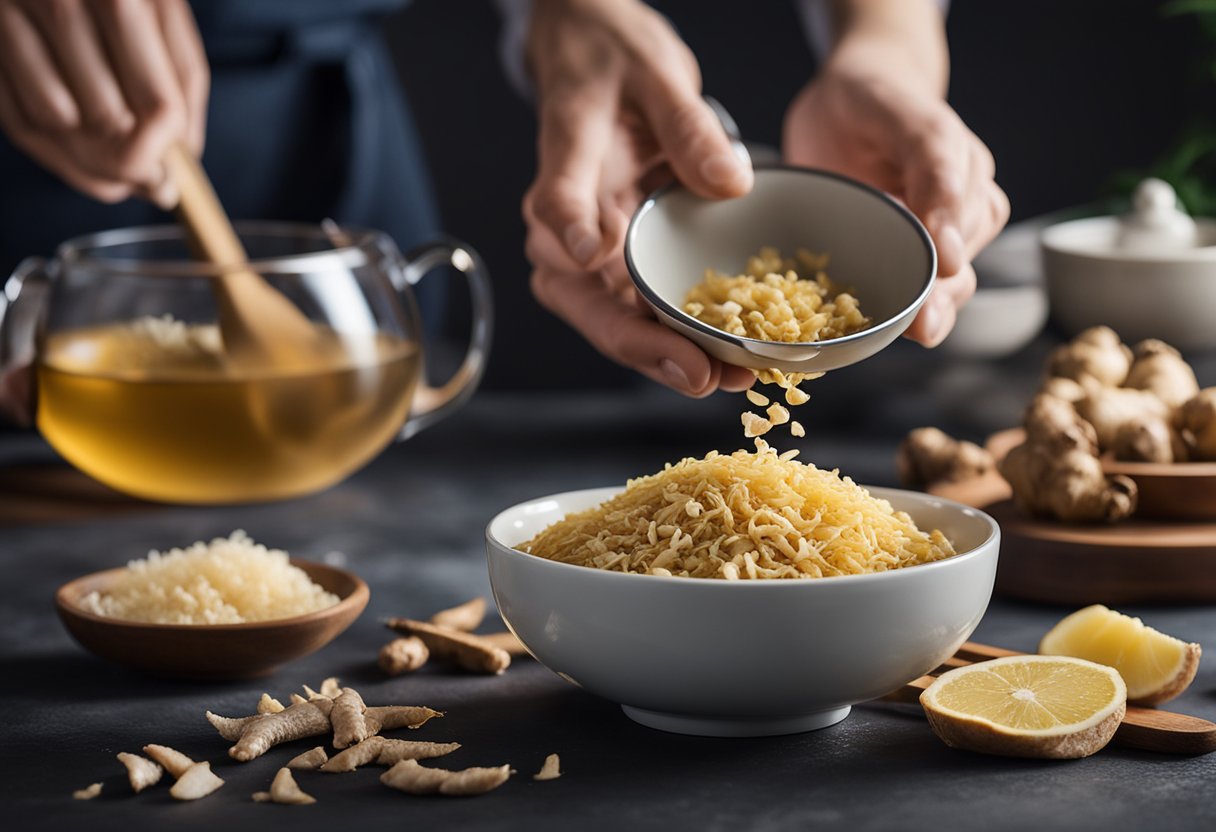
Ginger, a versatile root, carries a pungent flavor ideal for transforming any meal or drink. From spicing up a dish with its zest to sweetening a dessert, the culinary applications of ginger are vast and exciting.
Infusing Flavors with Ginger
To fully utilize ginger’s aromatic qualities, incorporate it into your teas and soups. For a comforting ginger tea, steep thinly sliced ginger in boiling water, then enhance it with honey to taste. Ginger acts as a key flavor enhancer in soups, releasing its warm essence when simmered with other ingredients.
- Tea: slice or grate ginger root into boiling water; add honey based on preference.
- Soups: sauté a bit of grated ginger before adding broth and other constituents.
Ginger in Baked Delights
Baking with ginger introduces a delightful zing to your treats. Whether you’re making gingerbread or adding depth to your cookies, ginger’s spice element elevates your baked goods.
- Gingerbread: blend ground ginger with your dry ingredients for the classic festive treat.
- Cookies: try incorporating minced crystallized ginger into cookie dough for a textured bite.
Healthy Ginger-Enriched Dishes
Ginger can also be a healthful addition to your cooking routine. Stir grated ginger into smoothies or whisk it into a ginger syrup to drizzle over nourishing dishes. Try blending ginger with coconut milk as a base for curries or flavorful smoothies.
- Smoothies: mix freshly grated ginger for an invigorating flavor boost.
- Ginger Syrup: simmer ginger in water and sugar to create a versatile syrup for various recipes.
Creative Concoctions with Ginger
Ginger’s vibrant flavor can elevate various drinks and sweets, transforming them into unique and enjoyable treats. Its versatility allows for a range of creative uses in the kitchen.
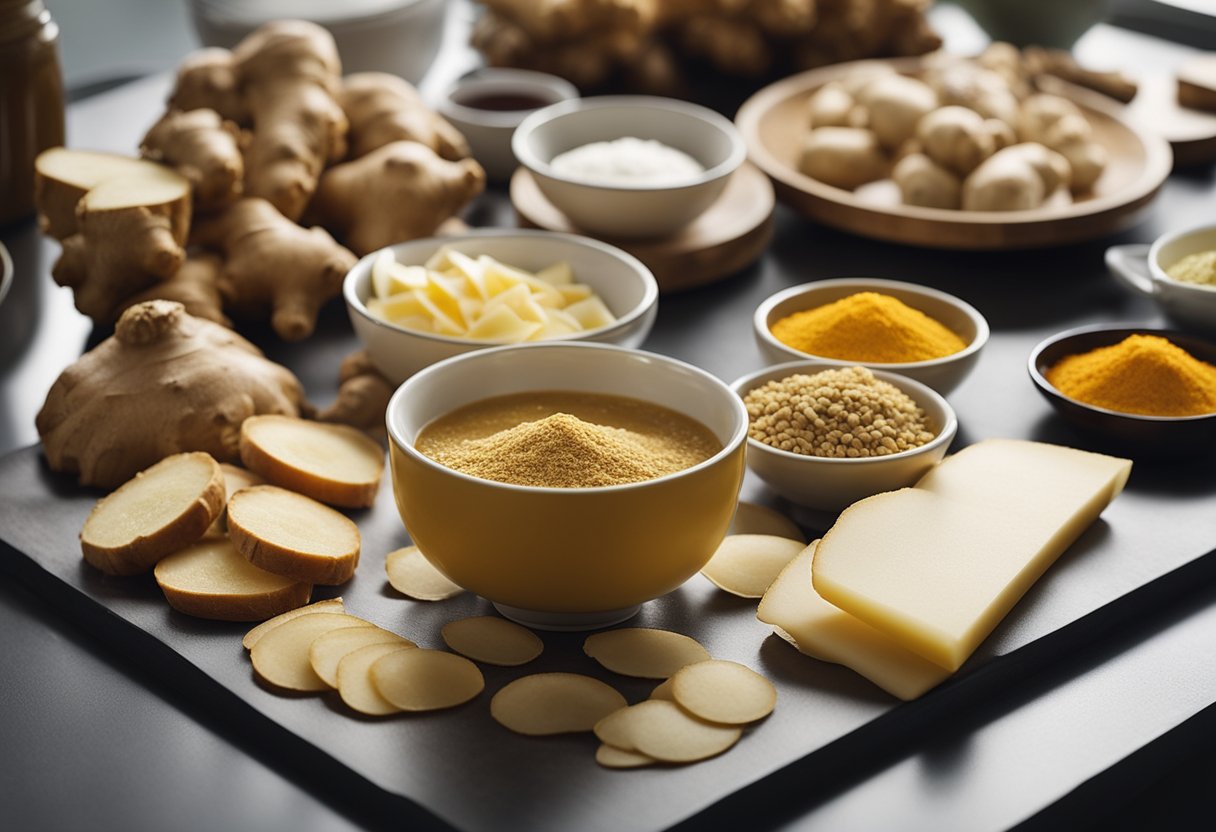
Homemade Ginger Ale & Cocktails
For a refreshing homemade ginger ale, combine 1 cup of finely grated ginger, 1 cup of sugar, and 2 cups of water in a saucepan. Simmer this mixture, then strain it to create a ginger syrup. Mix 1 part of this syrup with 3 parts sparkling water and squeeze a lemon wedge for taste. Serve over ice for a revitalizing homemade ginger ale experience.
Taking it up a notch, you can concoct ginger-based cocktails. Blend the ginger syrup with 2 ounces of brandy, 1 ounce of lemon juice, and ice. Shake well and strain into a chilled glass for a zesty, spirited delight.
Ginger-Infused Sweet Treats
Transform extra ginger into candied ginger by cooking sliced ginger in simple syrup until tender. Roll the slices in granulated sugar and let them dry. Enjoy these as a standalone snack or chop them to sprinkle over yogurt or baked goods for a sweet and spicy kick.
Pickled ginger isn’t just for sushi. Thinly slice fresh ginger and pickle it in a mixture of vinegar, sugar, and salt. Your homemade pickled ginger will be a delightful addition to salads or as a unique garnish for desserts, providing a contrasting tang.
Preserving and Transforming Ginger
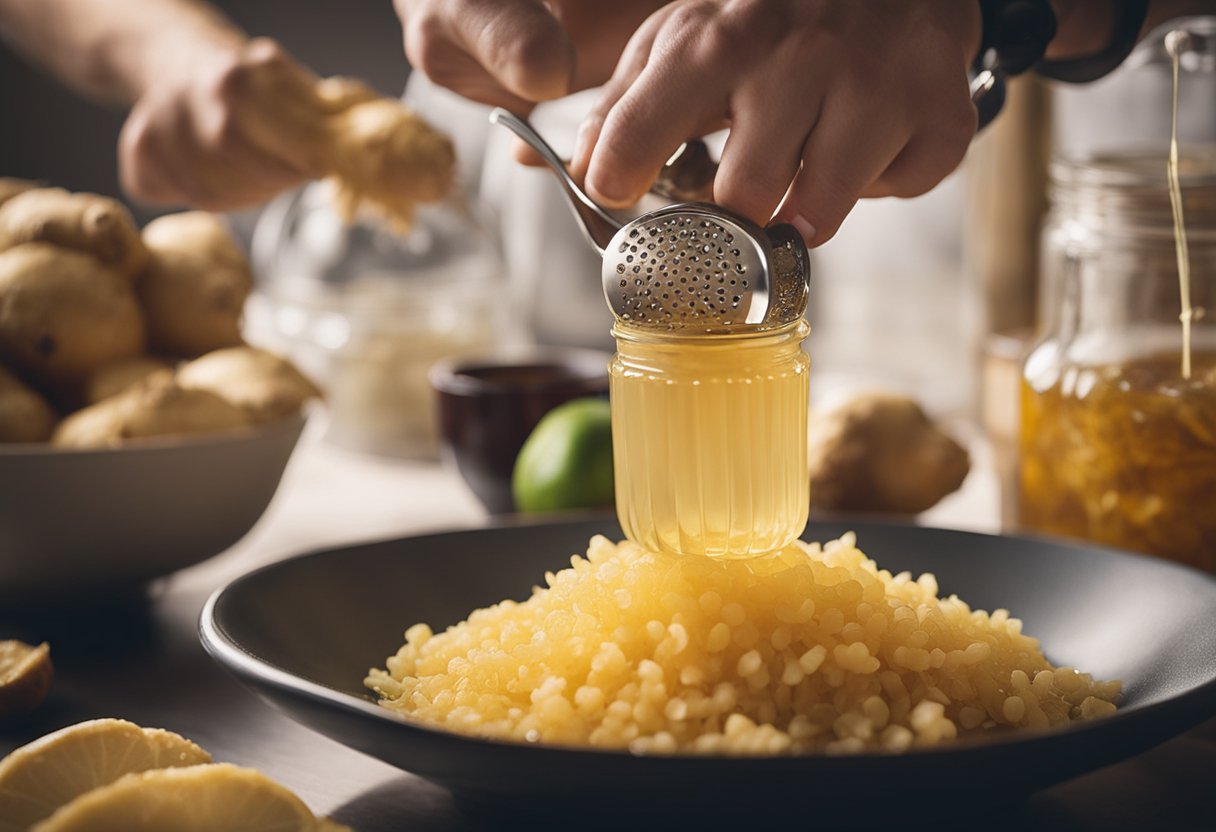
Preserving ginger extends its shelf life and enhances its versatility in your kitchen. This can be achieved through pickling or by creating pastes and powders, each method bringing out unique flavors and advantages for health and culinary uses.
Pickling for Flavor and Health
Ingredients:
- Fresh ginger
- Vinegar
- Sugar
- Salt
Instructions:
- Slice your ginger thinly after peeling.
- Combine equal parts vinegar and sugar in a pan, add a pinch of salt, and bring to a boil.
- Add ginger slices to the mixture and simmer for 15 minutes.
- Transfer the ginger and pickling liquid to a sterile jar and seal.
Benefits:
- Pickled ginger acts as an appetizer, promoting digestion.
- The anti-inflammatory properties of ginger may offer health benefits, possibly aiding with conditions like osteoarthritis.
Making Ginger Pastes and Powders
Ginger Paste:
Ingredients:
- Fresh ginger
- Oil
- Salt (optional)
Instructions:
- Peel and chop the ginger.
- Blend it with a small amount of oil to create a smooth paste.
- Store in airtight containers in the refrigerator for immediate use or freeze in ice cube trays.
Uses:
- The paste can be used in marinades, noodle soups, or to kickstart a squash bisque.
Ginger Powder:
Process:
- Peel and slice ginger thinly.
- Dry the slices until completely moisture-free to discourage mold.
- Grind the dried ginger to your desired consistency.
Storage:
- Keep your ginger powder in an airtight container in a dark, dry place.
Culinary Uses:
- The powdered ginger will serve as a convenient and concentrated form of flavor for curries, baked goods, and a variety of other dishes.
Frequently Asked Questions
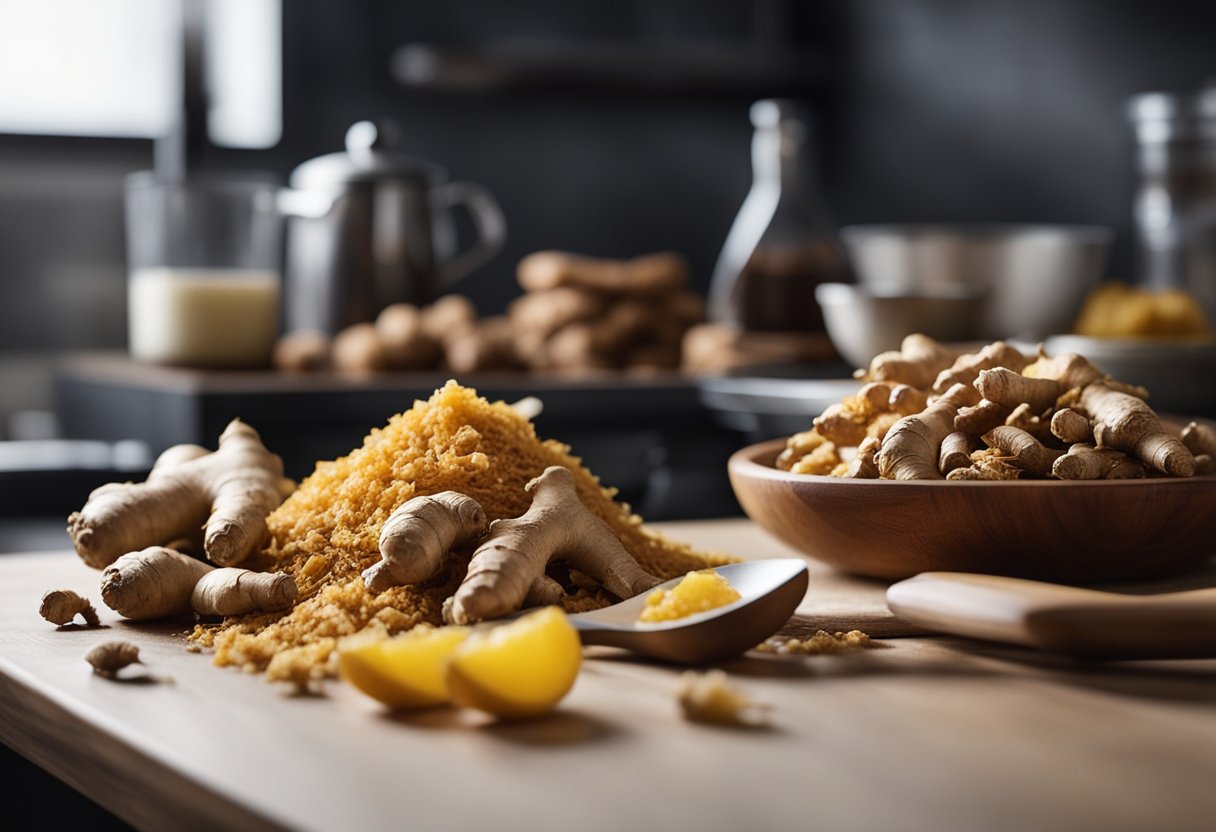
In this section, you’ll find practical ways to use extra ginger, from brewing a comforting tea to preserving it for future use.
How can I make ginger tea with fresh ginger?
To prepare ginger tea, slice 1-2 inches of fresh ginger root and steep it in boiling water for 10-15 minutes. You can add honey or lemon to enhance the flavor.
What are some healthy ginger-infused food recipes?
Try adding grated ginger to stir-fries or marinades for an aromatic zest. Ginger pairs well with vegetables and lean proteins like chicken or tofu.
Can you suggest ways to preserve excess fresh ginger?
Freeze ginger root by wrapping it tightly in plastic wrap or grate and store it in an airtight container in the freezer. You can also make ginger paste and refrigerate it.
What are easy-to-make ginger-root-based recipes?
Ginger can be a key spice in a simple carrot ginger soup or blended into a ginger dressing for salads. Both are straightforward recipes that bring out ginger’s flavor.
How do I create pickled ginger at home?
To pickle ginger, thinly slice the root and marinate it in a mixture of vinegar, sugar, and salt. Allow it to cure in the refrigerator for several hours or overnight.
What are some recipes that include both fresh ginger and garlic?
Fresh ginger and garlic can be used together in a flavorful stir-fry sauce or as a base for a savory meat marinade, complementing each other’s flavors well.
